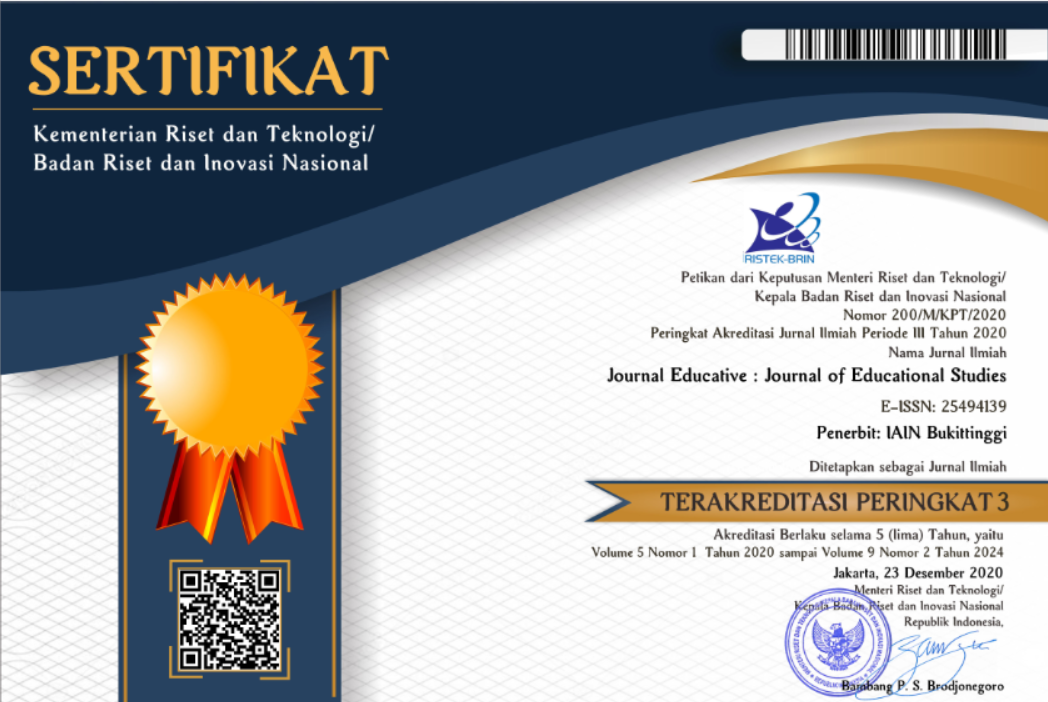CONSCIENTIOUSNESS AND EMOTIONAL STABILITY ON STUDENTS’ SPEAKING ABILITY THROUGH FLIPPED CLASSROOM
DOI:
https://doi.org/10.30983/educative.v3i2.544Abstract
The purpose of this study was to analyze the differences of students’ speaking ability in the Flipped Classroom model by using 1) audiovisual media, 2) printed media, 3) online learning WhatsApp and Massive Open Online English Course (MOOEC) in terms of students’ personality of conscientiousness and emotional stability. An experimental research method was used in this study where the data taken from 56 students who enroll class eleventh at Senior High School of MAN 3 Padang. They were divided into four different treatment groups. Students’ speaking ability data were collected by using Oral English Competence Test, while the personality data was measured by using questionnaires with 5-point Likert scale. The data analysis used one ways Anacova. Research findings reported that simultaneously the Flipped Classroom Model by using four different media have significant influence on students' speaking ability in terms of their conscientiousness and emotional stability, but partially was not significant differences on students' speaking ability where the conscientiousness have significant effect on students' speaking ability, but not to emotional stability. Flipped Classroom Model by using online learning WhatsApp and MOOEC highly contribute to the improvement of students' speaking ability than printed media. English teachers can take advantages of the use online learning media WhatsApp and MOOEC in the teaching of English speaking.
Â
References
Babakhani, N. (2014). The Relationship Between the Big-five Model of Personality, Self- regulated Learning Strategies and Academic Performance of Islamic Azad University Students. Procedia - Social and Behavioral Sciences, 116, 3542–3547. https://doi.org/10.1016/j.sbspro.2014.01.799
Buckingham, L. (2008). Development of English Academic Writing Competence by Turkish Scholars. International Journal of Doctoral Studies Volume, 3(2002), 1–18.
Creswell W John. (2014). Research Design, Qualitative, Quantitative and Mixed Methods Approaches (4th ed.). SAGE Publication, Inc.
Dewaele, J.-M., & Shan Ip, T. (2013). The link between foreign language classroom anxiety, second language tolerance of ambiguity and self-rated English proficiency among Chinese learners. Studies in Second Language Learning and Teaching, 3(1), 47–66. https://doi.org/10.14746/ ssllt.2013.3.1.3
Dörnyei, Z. (2005). Individual differences in second language acquisition. International Association of Applied Linguistics (AILA), 19(2005), 42–68.
Furnham, A., Chamorro-Premuzic, T., & McDougall, F. (200AD). Personality, cognitive ability, and beliefs about intelligence as predictors of academic performance. Learning and Individual Differences, 14(1), 49–66. https://doi.org/10.1016/j.lindif.2003. 08.002
Goldberg, L.. (2001). Big-Five-Markers-Psych.Assess. 1992.pdf. Psychological Assessment, 4, 26–42.
Gottfredson, L. S. (2003). Dissecting practical intelligence theory: Its claims and evidence. Intelligence, 31(4), 343–397. https://doi.org/10.1016/S0160-2896(02) 00085-5
Hadlield, J., & Donnyei, Z. (2017). Motivating Learning. Turkey: Modern Languages Department, Izmir, Turkey.
MacIntyre, P. D., Clement, R., Dornyei, Z., & Noels, K. A. (1998). Conceptualizing Willingness To Communicate In A L2 : A Situated Model Of Confidence And Affiliation. Modern Language Journal, 82(4), 545–562.
O’Connor, M. C., & Paunonen, S. V. (2007). Big Five personality predictors of post-secondary academic performance. Personality and Individual Differences, 43(5), 971–990. https://doi.org/ 10.1016/j.paid.2007.03.017
Öz, H. (2015). Investigating the Relationship between Foreign Language Learning and Call Attitudes among EFL Freshman Students. Procedia - Social and Behavioral Sciences, 176(March), 1041–1049. https://doi.org/10.1016/j.sbspro.2015.01.576
PaviÄićTakaÄ, &Požega, D. (2011). Personality traits, willingness to communicate and oral proficiency in English as a foreign language. Applied Linguistics Today: Research and Perspectives, 67–82.
Pourfeiz, J. (2015). Exploring the Relationship between Global Personality Traits and Attitudes toward Foreign Language Learning. Procedia - Social and Behavioral Sciences, 186, 467–473. https:// doi.org/10.1016/j.sbspro.2015.04.119
Rhodes, G. (2006). T He E Volutionary P Sychology of. Annu. Rev. Psychol. https://doi.org/10.1146/ annurev.psych.57.102904.190208
Robert GC. (2007). Understanding the dynamic of motivation in sport and physical activity: an achievement goal intepretation. (H. of sport Psychology, Ed.). John Wiley & Sons.
Downloads
Published
How to Cite
Issue
Section
Citation Check
License
Authors who publish with this journal agree to the following terms:
1. Authors retain copyright and grant the journal right of first publication with the work simultaneously licensed under a Creative Commons Attribution License that allows others to share the work with an acknowledgment of the work's authorship and initial publication in this journal.
2. Authors are able to enter into separate, additional contractual arrangements for the non-exclusive distribution of the journal's published version of the work (e.g., post it to an institutional repository or publish it in a book), with an acknowledgment of its initial publication in this journal.
3. Authors are permitted and encouraged to post their work online (e.g., in institutional repositories or on their website) prior to and during the submission process, as it can lead to productive exchanges, as well as earlier and greater citation of published work (See The Effect of Open Access).




